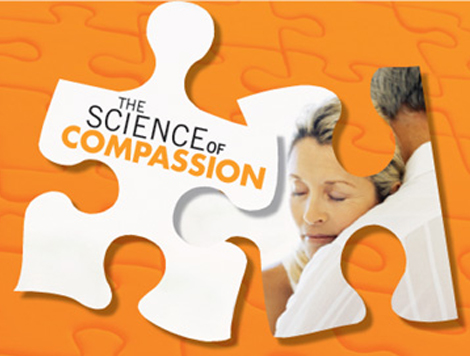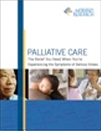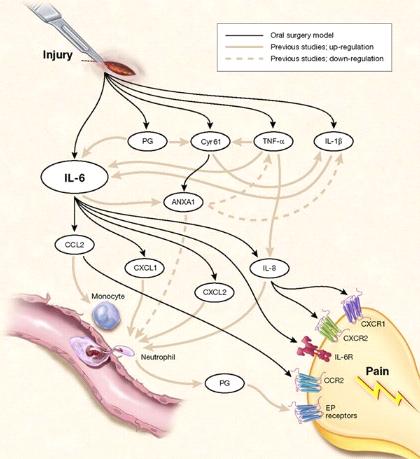Overview
Millions of Americans suffer from adverse symptoms such as pain that can inhibit their ability to lead normal lives. Pain can be a debilitating symptom of chronic diseases such as arthritis and diabetes, and chronic pain can itself become a chronic disease. Throughout its history, NINR has supported research on new and better ways to manage the symptoms of illness, including pain. Research supported by NINR focuses on understanding the biological and behavioral aspects of pain, with the goal of developing new knowledge and new strategies for improving patient health and quality of life.
The Institute supports research at universities, hospitals, and other institutions across the Nation; and, in addition, NINR maintains a robust intramural research program on the NIH Campus in Bethesda, Maryland. Taken together, NINR’s extramural and intramural pain research focuses on: 1) improving the understanding of the range of underlying biological mechanisms of acute and chronic pain; 2) illuminating the biological and behavioral processes through which patients respond to pain management interventions; and, 3) developing and testing effective pain management interventions.
Finding new and better ways to manage adverse symptoms is vital to improving quality of life for those with illness. This webpage provides a broad overview of NINR’s activities in pain research, highlighting recent research findings, program initiatives and other research efforts. For more information on NINR’s portfolio in pain research, links to staff contacts are provided.
Selected NINR Research Highlights in Pain
Listed below are several highlights of research accomplishments in pain from the community of NINR-supported scientists across the U.S. Links to PubMed citations are provided for each publication.
Biology of Pain:
- In order to improve the understanding of how inflammation and pain interact, scientists are examining a newly discovered relationship between the expression of several genes and the development of acute inflammation and clinical pain (http://www.ncbi.nlm.nih.gov/pubmed/19233564).
- A team of scientists has discovered a molecular process that could be targeted with therapeutic interventions to prevent or reduce painful side-effects of HIV treatment. (http://www.ncbi.nlm.nih.gov/pubmed/19398414)
- Scientists are examining how stress hormones contribute to neuropathic pain and how certain hormone-inhibiting therapeutics may modulate stress-related pain syndromes. (http://www.ncbi.nlm.nih.gov/pubmed/19361551)
- Scientists are currently studying the complex molecular pathways that cause pain, as well as the mechanisms by which analgesics act to relieve pain in some people. (http://www.ncbi.nlm.nih.gov/pubmed/18288087)
Assessment and Management of Pain:

- The Palliative Performance Scale provides accurate planning timelines in end-of-life settings in diverse communities. (http://www.ncbi.nlm.nih.gov/pubmed/18823751)
- Behavioral, individualized, educational programs may reduce patient-related barriers to effective pain management. (http://www.ncbi.nlm.nih.gov/pubmed/18230015)
- Integrating palliative care into nursing homes may address the care needs of patients and families while addressing the organizational challenges relating to hospice eligibility, staffing, training, and obtaining adequate reimbursement for care. (http://www.ncbi.nlm.nih.gov/pubmed?term=%2021266284)
- Scientists are currently adapting and testing an instrument to measure acute pain in people whose conditions, such as dementia and cognitive impairment, prevent them communicating their pain symptoms. (http://www.ncbi.nlm.nih.gov/pubmed?term=%2021265631)
- Scientists from the University of California San Francisco, School of Nursing adapted a successful pain self-management program, originally developed for adults with cancer (PRO-SELF©), and demonstrated positive results in parents’ management of their children’s post-surgical pain at home. (http://www.ncbi.nlm.nih.gov/pubmed?term=21951354)
- Scientists at the National Institute of Nursing Research developed a device for collecting patient-reported outcomes related to pain, the “Gastrointestinal Pain Pointer” (GIPP), that permits a patient to describe subjective components of pain on a graphic interface and stores the data electronically for quantification and comparison to later reports of pain. (http://download.journals.elsevierhealth.com/pdfs/journals/0016-5085/PIIS0016508510622111.pdf)
- Researchers are examining successful, non-pharmacological strategies used by caregivers to help women deal with pain and distress during the second stage of labor. (http://www.ncbi.nlm.nih.gov/pubmed/20129228)

NINR Initiatives in Pain Research
NINR issues calls for applications in a number of specific research areas related to symptom management. The Institute also co-sponsors research initiatives in pain led by other NIH Institutes and Centers. Selected recent initiatives are listed below.
A complete list of NINR funding opportunity announcements (FOAs) can be found at this link: NINR FOAs
| Announcement Number | Release Date | Expiration Date | Activity Code | Title |
|---|---|---|---|---|
| RFA-MH-12-140 | 01/27/2012 | 04/17/2012 | R21 | Development of Tools to Study the Synaptome (R21) |
| RFA-NR-12-004 | 12/02/2011 | 03/23/2012 | R01 | Palliative Care and End of Life in People Living with HIV/AIDS(R01) |
| RFA-NR-12-005 | 12/02/2011 | 03/23/2012 | R21 | Palliative Care and End of Life in People Living with HIV/AIDS (R21) |
| PAR-10-204 | 05/21/2010 | 09/29/2012 | R01 | NIH Blueprint for Neuroscience Research Competitive Revisions for Studies Focused on Neuropathic Pain or Neural Plasticity to Promote Collaborative Pain Research (R01) |
| PA-10-006 | 10/05/2009 | 01/08/2013 | R01 | Mechanisms, Models, Measurement, and Management in Pain Research (R01) |
| PA-10-007 | 10/05/2009 | 01/08/2013 | R21 | Mechanisms, Models, Measurement, & Management in Pain Research (R21) |
| PA-10-008 | 10/05/2009 | 01/08/2013 | R03 | Mechanisms, Models, Measurement, and Management in Pain Research (R03) |
| RFA-NR-12-011 | 03/19/2012 | 05/22/2012 | R01 | Research to Assist Informal Caregivers in Assessing and Managing Symptoms in Individuals with Alzheimers Disease (R01) |
| RFA-NR-12-006 | 03/09/2012 | 05/17/2012 | P30 | Centers of Excellence in Symptom Science (P30) |
| RFA-NR-12-009 | 03/09/2012 | 05/17/2012 | P20 | Centers of Excellence in Symptom Science: Building Research Teams for the Future (P20) |
Other NINR Pain Research Activities

Title: NINR Pain Methodologies Boot Camp
Description: In July of 2010 and July of 2011, NINR conducted two week-long, intensive pain research training courses to provide a foundation in methodology for use in pain research and to increase the research capabilities of graduate students and faculty.
Website Link: NINR Pain Methodologies Boot Camp
Title: NINR-NIH Clinical Center Joint Conference: Symptom Mechanisms, Measurement, and Management
Description: On May 12, 2011, the Symptom Mechanisms, Measurement, and Management conference was held to present information to researchers, clinicians, science writers, and the interested public regarding a number of symptom-related topics including: symptom self-management in oncology patients, pain management at the end-of-life, sleep disorders, and genetic mechanisms of cancer treatment-related fatigue.
Website Link: NINR-NIH Clinical Center Joint Conference: Symptom Mechanisms, Measurement, and Management

Title: The Science of Compassion: Future Directions in End-of-Life and Palliative Care
Description: Management of pain associated with advanced illness through palliative care, particularly at the end of life, remains an unmet need. Addressing this issue, in August, 2011, NINR, in partnership with NIA, NCCAM, ORDR, ORWH, and the NIH CC Office of Bioethics, convened a three-day national Summit on, “The Science of Compassion: Future Directions in End-of-Life and Palliative Care.”
- The Summit examined the state of research and clinical practice in end-of-life and palliative care and, with almost 1,000 registrants, provided an opportunity for scientists, health care professionals, and public advocates to come together to catalyze and shape the future research agenda for this critical scientific area.
- The Summit served as a significant milestone not only to reflect on past accomplishments, but to address the scientific contributions of one of the most important areas of health care in our Nation today.
- NINR is currently assessing the recommendations provided by the distinguished Summit participants as the Institute develops future research initiatives.
Website Link: The Science of Compassion: Future Directions in End-of-Life and Palliative Care

Title: Palliative Care: The Relief You Need When You're Experiencing the Symptoms of Serious Illness
Description: In 2009, NINR published a palliative care brochure, "Palliative Care: The Relief You Need When You're Experiencing the Symptoms of Serious Illness". NINR has also published a Spanish version: "Cuidados Paliativos: El Alivio que Necesita Cuando Tiene Síntimos de una Enfermedad Grave".
NINR Pain Research Contacts
NINR Office of Extramural Programs
Dr. Susan Marden: Symptom Management (e.g. Pain, Fatigue, Nausea)
Dr. Noreen Aziz: Palliative Care and End-of-Life, Long-Term Care
Dr. Xenia Tigno: Biobehavioral Research
Dr. David Banks: Training and Fellowship Opportunities (Individual)
Dr. Donna Jo McCloskey: Training and Fellowship Opportunities (Institutional/T32)
NINR Intramural Research Program
Dr. Marguerite Engler: Acting Deputy NINR Scientific Director
Dr. Mary Engler: Intramural Research Training
For All Other Inquiries:
NINR Office of Science Policy and Public Liaison: 301-496-0207
Other Pain Research Resources: NIH Pain Consortium







